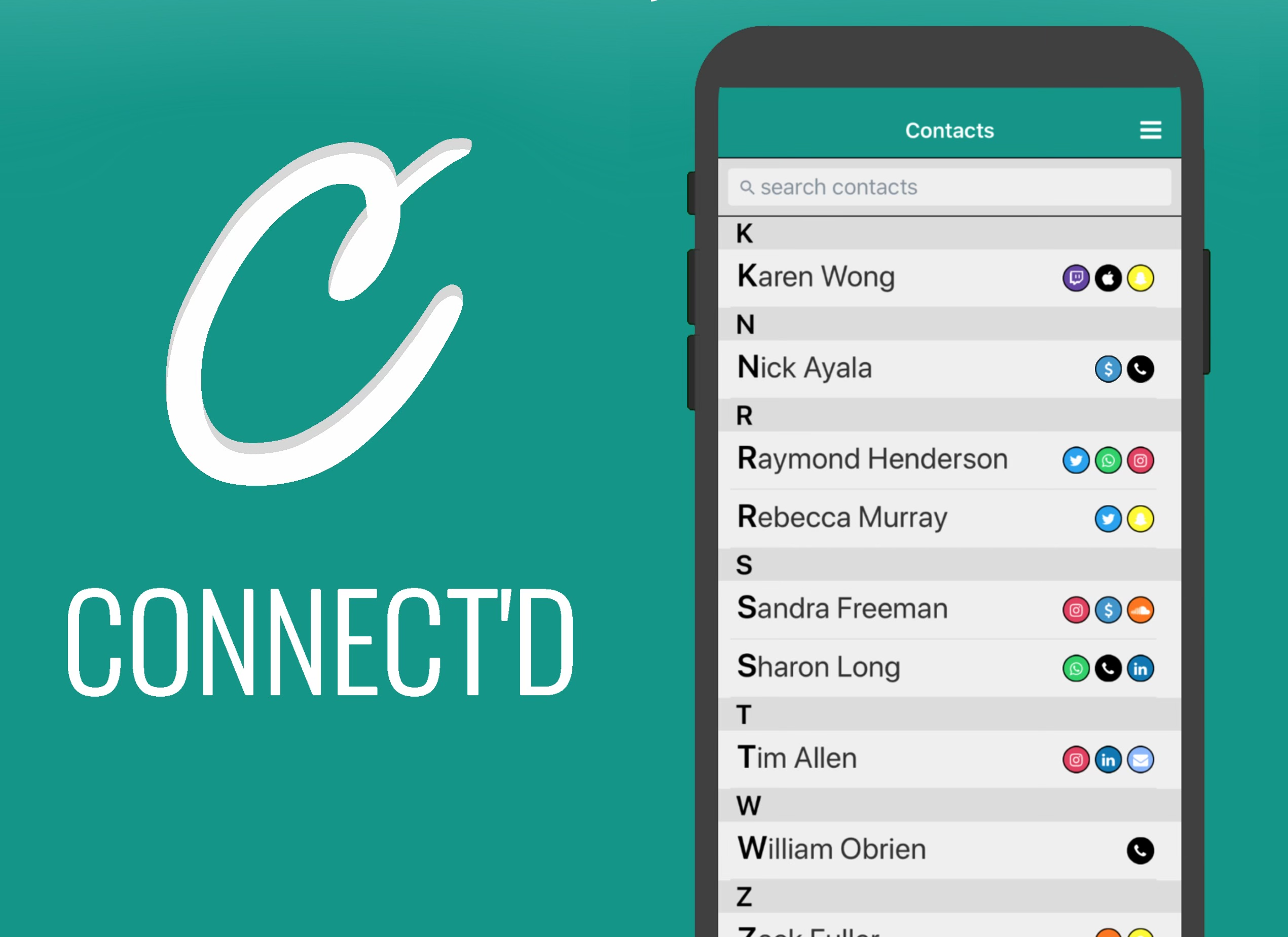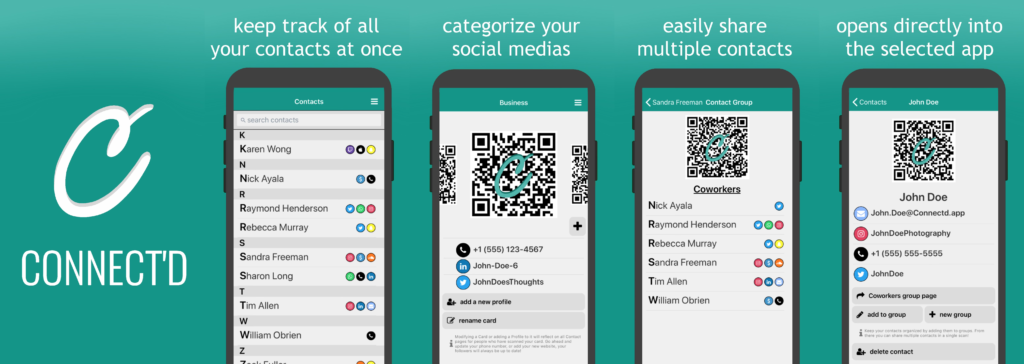Connect’d [Founder] – A social contacts app.

2018 (San Jose, CA) – WeChat is leading how mobile applications are used. Similar to how someone uses a web browser as their gateway to the internet, WeChat is the gateway to all other apps. Rather than downloading an app for Uber, Citibank, and Facebook; imagine one mobile application for them all.
The concept is explained well by the New York Times in a short YouTube video, but begs the question, “Where is the equivalent in the United States?”
WeChat started as a messaging platform that slowly added additional features and capabilities. However in the United States, there were already large messaging platforms like Facebook Messenger or iMessage. How could a new startup develop a similar application to WeChat without competing with the large messenger incumbents?
What is a mobile application that has experienced little to no innovation since its inception?
The Contacts app!
Summary
This was a blue ocean! No one was innovating in this space. We spun up a new company called AddMe LLC and came up with a creative application name, Connect’d. The game plan was simple:
- Step 1: Create an innovative contacts application that every will want to use
- Step 2: After mass adoption, expand features to create the USA version of WeChat
Writing out a two-step strategy was significantly easier than executing the plan. Finding a core problem that a majority of users experienced, specifically around the Contacts app experience, was extremely difficult.
Founding Team
Reflecting on some of the learnings that I had from my prior startup endeavor, QMi Systems, I wanted to keep the team as lean so that we can move as quickly as possible.

Nick Ayala

Tim Allen
Customer Discovery
In order for Connect’d to be successful, we would need to launch the application during a time where exchanging contact information is top of mind. There were two that immediately came to mind.
First were networking events, specifically corporate or industry-specific conferences. During conferences, people are often exchanging information with other attendees and vendor booths. However, exchanging only a business email will suffice. There isn’t enough variability between the different types of contacts to exchange.
The second scenario that we believed would have a high frequency of exchanges and variability of contact types would be in the University setting. Contrary to a business conference, individuals in a social setting can exchange a myriad of contacts from social platforms like Facebook and Snapchat to more direct contact information like their phone number. For each exchange, their type of contact information might change. This variability might just be enough for Connect’d!
App Features
The Connect’d application had a familiar layout to a standard contact application, however, a user could customize specific “cards”, each with a unique QR code. When someone scanned the QR code, they would only share the pre-configured contact information with that card.
Going to the bars? Setup a card only with your Snap or Instagram.
Networking in Class? Setup a card only with your college email and phone number.

Funding
We did not raise any outside funding for this venture.
Go-to-Market (GTM) Difficulties
We partnered with a number of San Jose State University fraternities and sororities that would use Connect’d to track the attendance during their events. Someone would enter the event, download the application, and then be able to exchange their contacts throughout the events.
It was a total disaster.
Asking someone to download the application before entering took too long. It caused lines to form, dissatisfaction, and impatience. Immediately the groups moved back to physical paper or Google Form sign-ins to track attendance.
For future events, we sent a request for attendees to download the app before arriving hoping that will reduce some of the friction the day of. Most of the attendees didn’t download the app prior, and those that didn’t showed up without RSVPing experienced the same hectic experience that other attendees had at prior events.
By this time the fraternities and sororities had lost any patience with the app, and refused to use it at any future events.
We had made one fatal mistake. Requiring that someone would download the application without having the option to use it in a web browser or another lower friction way made the application useless.
Key Takeaways
Build for a problem
At the core, user adoption and retention was difficult because we had built a solution for an unknown problem. Our early users downloaded the application because they were either our personal friends, or because they were forced to use it to attend an event. But what we thought would be the more organic use-case of exchanging contacts never took off. There was either too much friction with requiring an app to be downloaded, or the need to exchange a custom set of contacts wasn’t enough. It was hard to compete with “What’s your Snap?”
Learning: Clearly define the problem and work backward from there. Don’t have a solution in search of a problem.
Competing against operating system’s native app is hard
When creating an application that competes against an application that is standard on all mobile devices, there needs to be a compelling reason for users to adopt something new. In the case of Facebook Messenger, users adopted the Messenger application because they didn’t have the phone numbers of individuals they had on the platform. That is a compelling enough reason to download a different messaging application. Sharing multiple contacts with someone isn’t easy, but it isn’t a blocker when connecting with someone new.
Learning: There needs to be a use case that 100% cannot be fulfilled with current applications to create enough pain for users to adopt something new.
Early technology needs an inflection point
The primary transaction for contact sharing was using QR codes. At the time, these were still early along the adoption curve, and in some cases, seemed gimmicky. With the added complexity of requiring any two parties to have the app downloaded to access the QR codes, this created an enormous amount of friction for our users. Learning: Leveraging technology that is already being adopted by the early majority will reduce user friction.
Don’t try to be clever with your naming
At the time of founding, we thought we were so smart. Connect’d. It’s a small learning, but if you need to spell the name of your application to EVERYONE that you come into contact with, it’s probably NOT a good name.
Learning: Be innovative with the solution you are building, not with the spelling of your startup.
Shutting Down Connect’d
After the first wave of events with the various student organization partners had failed, we tried to rebuild the application with lower friction options. Each time the application receive little to no adoption. With no clear path to user adoption after 12 months, we decided to shut the app down and focus on other projects.

![Clubhouse [Early Employee] – Learnings During High-Growth & Next Career Chapter with Fair Square Medicare](https://legacy.nicholasayala.com/wp-content/uploads/2023/06/Goodbye-Clubhouse-Hello-FSM-3-768x432.png)
![QMi Systems [Founder] – Increasing University Food Service Revenue through Pre-orders.](https://legacy.nicholasayala.com/wp-content/uploads/2023/06/QMi-Cover-Photo-copy-768x559.png)